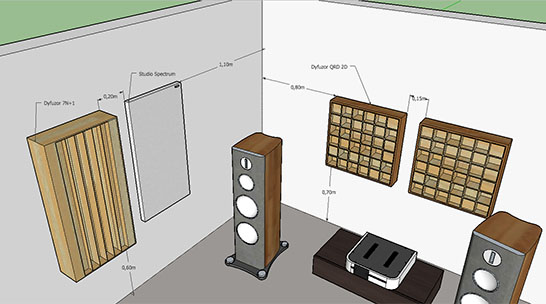No products in the cart.
Applications, General
How to treat room acoustics.

BASICS OF ACOUSTICS
Explanation of the most common problems and ways to deal with them
Primary reflections
Every time you listen to music or mix a song, you hear a combination the sound that comes directly from the speakers and its reflections off different surfaces. Sound is constantly being reflected off the walls, floor and ceiling. Some reflections reach your ear faster than others – you hear them as an echo. They are called early reflections and have a huge impact on how you hear the sound.
Sound is reflected from a surface at the same angle at which it strikes the surface. Knowing this principle, you can easily locate early reflection points in your room. Treating these places with the use of acoustic panels can significantly increase the quality of sound in your room and make it more suitable for mixing and recording,
Bass Absorption
As you know, all acoustic problems are caused by reflections from the walls, floor, and ceiling. One of the biggest problem caused by sound reflections is modal ringing (also knows as room resonance). It’s similar to reverb, but it occurs only at specific frequencies related to the room dimensions. These resonant frequencies are called room modes and they are one of the most important acoustic problems to solve.
Bass traps are specially designed acoustic absorbers which are dedicated to damp low frequency sound energy and reduce peaks, nulls, and modal ringing. Placing bass traps in room corners affects all room modes and improve the low frequency response.
Adding sound diffusion
In order to get a comfortable listening environment it is recommended to control interfering reflections and provide ambient sound field using diffusion instead of absorption in some places of the room. Sound diffusion is more natural to human ear, because acoustic diffusers don’t absorb sound energy, but they disperse it, spreading out the energy around the room.
Using absorption panels only can sometimes make a room sounds uncomfortably dead . Adding sound diffusion to an acoustic room treatment can significantly improve the overall listening environment within the room, without adding excessive amounts of sound absorption materials. Mathematically optimized Acoustic Diffusers help in conserving sound energy and also help spread it around to achieve even distribution. Additionally, diffusion can give the impression of a larger space, which is good for smaller listening rooms.


